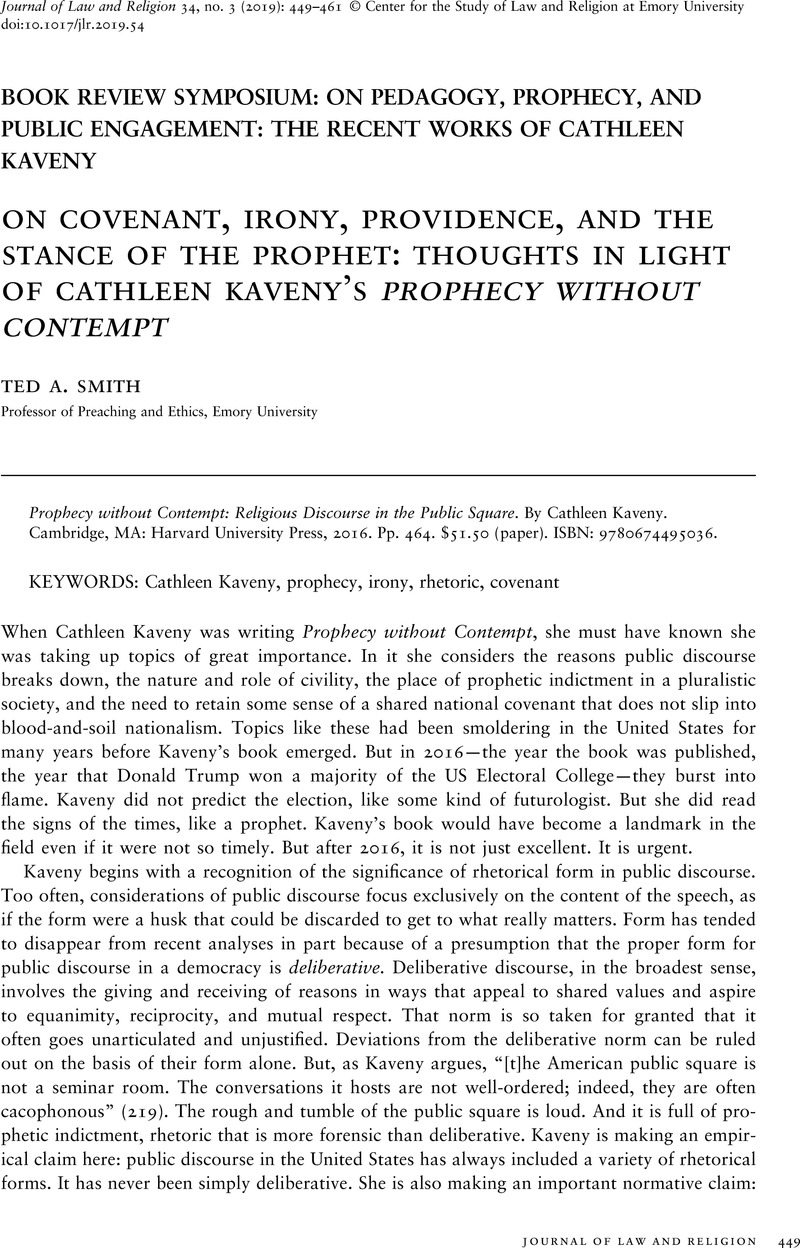No CrossRef data available.
Article contents
ON COVENANT, IRONY, PROVIDENCE, AND THE STANCE OF THE PROPHET: THOUGHTS IN LIGHT OF CATHLEEN KAVENY'S PROPHECY WITHOUT CONTEMPT - Prophecy without Contempt: Religious Discourse in the Public Square. By Cathleen Kaveny. Cambridge, MA: Harvard University Press, 2016. Pp. 464. $51.50 (paper). ISBN: 9780674495036.
Review products
Published online by Cambridge University Press: 24 February 2020
Abstract

- Type
- Book Review Symposium: On Pedagogy, Prophecy, and Public Engagement: The Recent Works of Cathleen Kaveny
- Information
- Copyright
- Copyright © Center for the Study of Law and Religion at Emory University 2020
References
1 Kaveny's argument could be even stronger, I think, if she extended her consideration of rhetoric to include the embodied performance of these indictments. Things like the dress of the speakers, the spaces in which they spoke, the timbre of their voices, and the ways they moved their bodies all matter for the questions Kaveny considers. Jeanne Halgren Kilde makes these connections in When Church Became Theatre: The Transformation of Evangelical Architecture and Worship in Nineteenth-Century America (New York: Oxford University Press, 2005). I make my own attempt in Smith, Ted A., The New Measures: A Theological History of Democratic Practice (New York: Cambridge University Press, 2007)Google Scholar.
2 See Bercovitch, Sacvan, The American Jeremiad (Madison: University of Wisconsin Press, 1978)Google Scholar.
3 Wills, Garry, Lincoln at Gettysburg: The Words That Remade America (New York: Simon & Schuster, 2006)Google Scholar. In considering Wills's argument, Kaveny notes that the Declaration of Independence did not have the same kind of binding, covenantal force as the Constitution—and that Lincoln surely understood this. Both of these points are certainly true. But I take Wills's point to be less about the status of law and more about the shared American imaginary. If anything, the weaker status of the Declaration makes Lincoln's attempt to move it to the center of a shared sense of national covenant even more of a creative act.
4 Here I think an analogy from the work of Alasdair MacIntyre can be instructive. MacIntyre famously argues that rationality must be rooted in a tradition. When he presents his argument most subtly, he is clear that tradition is not simply found, but is rather constructed in a creative act of narration. Tradition is not made from nothing. The narrator cannot invent just any way of connecting the dots. But some kind of creative action cannot be avoided in the positing of tradition. MacIntyre, Alasdair, After Virtue: A Study in Moral Theory, 3rd ed. (Notre Dame: University of Notre Dame Press, 2007)Google Scholar, chapter 15. I suggest that a similar sort of bounded creativity is at work in defining the covenant to which the speaker of a jeremiad might appeal.
5 Calls for restoration of some kind of imagined Puritan ideal abound. See, for instance, Gorski, Philip, American Covenant: A History of Civil Religion from the Puritans to the Present (Princeton: Princeton University Press, 2017)Google Scholar. See also Ted A. Smith, review of American Covenant: A History of Civil Religion from the Puritans to the Present, by Philip Gorski, Journal of the American Academy of Religion 85, no. 4 (2017): 1160–63.
6 For thoughtful guidance to preachers that resonates with Kaveny's suggestions, see Tisdale, Leonora Tubbs, Prophetic Preaching: A Pastoral Approach (Louisville: Westminster John Knox, 2010)Google Scholar.
7 Du Bois, W. E. B., The Souls of Black Folk (New York: Bantam Books, 1989), 3Google Scholar.
8 Baldwin, James, “Encounter on the Seine: Black Meets Brown,” in Collected Essays, ed. Morrison, Toni (New York: Library of America, 1998), 89Google Scholar.
9 Martin Luther King, Jr., “Letter from a Birmingham Jail,” Christian Century (June 12, 1963), 771–73. An early draft of the letter and an audio recording of Dr. King reading the letter are available through the The Martin Luther King, Jr. Research and Education Institute at Stanford University, https://kinginstitute.stanford.edu/king-papers/documents/letter-birmingham-jail.
10 For a description of the recordings, see Rieder, Jonathan, Gospel of Freedom: Martin Luther King, Jr.'s Letter from Birmingham Jail and the Struggle That Changed a Nation (New York: Bloomsbury, 2014), xviGoogle Scholar.
11 King, “Letter from Birmingham Jail,” 772.
12 Rieder, 89.
13 King, “Beyond Vietnam” (speech, Riverside Church, New York, NY, April 4, 1967), https://kinginstitute.stanford.edu/king-papers/documents/beyond-vietnam.
14 King, “Beyond Vietnam,” 13:02.
15 For the letter of the Alabama clergymen, see C. C. J. Carpenter, et al., “A Call for Unity,” reprinted by the American Friends Service Committee, 1963. Archives of The Martin Luther King, Jr. Research and Education Institute, Stanford University, http://mlk-kpp01.stanford.edu/kingweb/popular_requests/frequentdocs/clergy.pdf.
16 Abraham Lincoln, “Second Inaugural Address” (speech, Washington, DC, March 4, 1865), http://avalon.law.yale.edu/19th_century/lincoln2.asp.
17 For the sense of certainty I am trying to suggest, see Wittgenstein, Ludwig, On Certainty (Oxford: Basil Blackwell, 1969)Google Scholar.




